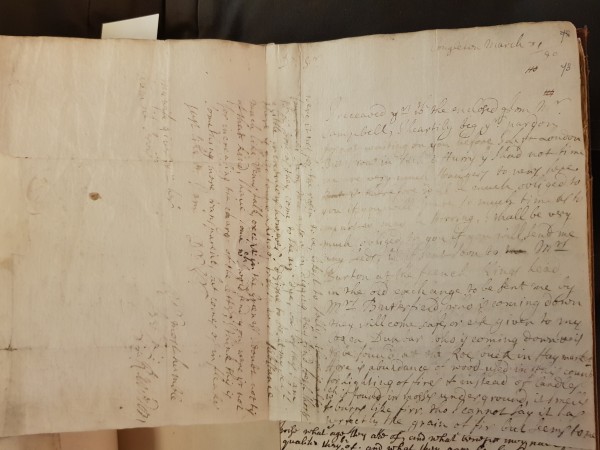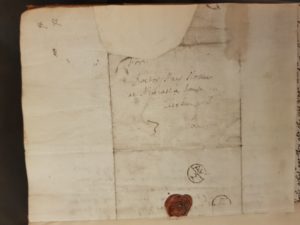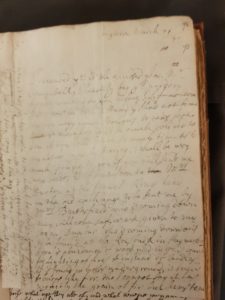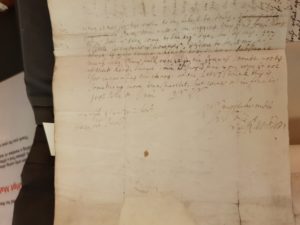By James Hawkes
The Royal Society is in turmoil as competing factions battle for control. Not only is our hero Hans Sloane’s job on the line, but the very existence of the Royal Society hangs in the balance…

Dr. John Woodward (Credit: Wikimedia Commons. Uploaded by: Dcoetzee)
No this is not the TV Guide summary of a niche costume drama, but the results of a bitter dispute between Dr. Hans Sloane and Dr. John Woodward in 1710. Not only did these men have starkly different visions for the future of the Royal Society, but they were competitors for rare curiosities and specimens. It’s perhaps not surprising that the men became rivals! Woodward launched a concerted campaign to unseat Sloane, which nearly succeeded.
Woodward, professor of Physic at Gresham College, championed a highly empirical and experimental approach for the Royal Society. He resented Sloane’s tendency to publish an increasingly ‘miscellaneous’ assortment of articles in the Royal Society’s Philosophical Transactions–particularly those written by Sloane’s friends. (This was, admittedly, a complaint even by men who liked Sloane!) Woodward naturally considered the man most disadvantaged by this unjust state of affairs to be himself. He made it his mission to save the Royal Society from those he feared would undermine the scientific progress of mankind.
Sloane and Woodward actually had much in common: they were both medical doctors with a deep-seated curiosity about the natural world. They were also active in the Royal Society and the Royal College of Physicians. Both earned considerable respect for their scholarly endeavours: Sloane, for his botanical work on the West Indies, and Woodward, for his prolific writings, especially on geology. Each man had a circle of scientific contacts across the British Empire and the Continent.
Sloane and Woodward also built impressive collections of natural and antiquarian items, preserved for posterity by (respectively) the British Museum and the Woodward Professorship at Cambridge. Woodward is even on record in a letter to Sloane declaring that he thought himself Sloane’s friend… albeit in the context of trying to explain away intemperate remarks about Sloane.
But the Devil is always in the details. Sloane had a reputation for collecting pretty much anything that fell into his hands. Woodward, however, focused on what he thought to be academically useful. These different approaches helped Woodward to drive a wedge between Sloane and Sir Isaac Newton (then President of the Royal Society), who had little respect for Sloane’s collecting habits.
The situation finally exploded in 1709 when Sloane, as First Secretary of the Royal Society, published a book review by Woodward’s long-standing enemy Edward Lhwyd. In his review of the work of a Swiss geologist, Lhwyd went out of his way to ridicule Woodward’s theories. Woodward demanded satisfaction. One contemporary said he did not know if the affair would end
whether by the sword or by the pen. If the former, Dr. Mead has promised to be Dr. Sloane’s second.(Levine)

One conflict resolution option. Credit: Wikimedia Commons, user Noodleki.
Dr. Mead was, of course, another one of the many enemies that Woodward was so good at making. Indeed, ten years later Mead and Woodward duelled to resolve a dispute on the best way to treat smallpox. There are many versions of what happened. According to one, with Woodward defeated Mead bellowed, “Take your life,” to which Woodward replied, “Anything but your Physic.” But that is another story.
In an attempt to keep the bickering between Woodward and Sloane from escalating into violence, Sir Isaac Newton forced Sloane to publish a retraction, indicating he thought some of Woodward’s ire was justified. Woodward’s plans to overthrow Sloane nonetheless continued apace. Woodward managed to get a friend, John Harris, elected secretary. He then proclaimed in a letter to Ralph Thoresby that:
Dr. Sloane declared at the next Meeting he would lay down…. He guesses right enough that the next step would be to set him aside.
Woodward and his faction were so confident by this point that he criticised Newton as incapable. Harris even invited Newton’s nemesis, Leibniz, to write for the Transactions. Perhaps Woodward’s ambition was becoming so great that he hoped to be Newton’s successor as President of the Royal Society–an honour that would fall to Sloane much later, in 1727.
The power struggle culminated when Sloane was presenting on bezoars to the Society. Woodward attacked Sloane’s thesis and Sloane, unable to come up with a reply, allegedly resorted to making faces at Woodward. These grimaces were “very strange and surprising, and such as were enough to provide any ingenuous sensible man to a warmth.”

If only we knew what the grimace was… Engraving, c. 1760, after C. Le Brun. Credit: Wellcome Library, London.
The Council was convened to resolve this controversy once and for all. They debated whether Sloane had actually been making faces and whether Woodward’s ire was justified. Woodward seemed on the brink of victory, but then lost his temper when Sloane denied the charges: “Speak sense, or English, and we shall understand you!” Woodward, unwilling to apologize was summarily kicked out. He then claimed that Sloane had packed the Council with his cronies, complaining to no avail of the “Mystery of Iniquity that reigns there.” His friend Harris was soon enough replaced and so his entire revolution fell apart.
Although it may be more amusing to think of these eminent doctors as perpetually busy with childish bickering, they were capable of acting professionally on occasion. Even after this great controversy Woodward was willing to recommend Sloane to a patient and attempted to enlist Sloane’s support to obtain a lucrative new position. Still, their showdown does appear to have put a bit of a damper on their correspondence, and it would seem that their relationship never entirely recovered.
As it happened, with Woodward gone, Sloane and Newton soon fell to sniping at one another. When Sloane was forced to resign as secretary in 1713, Woodward ended up on the side of Sloane against Newton, who Woodward now saw as an evil tyrant holding the Society back.
The more things change, the more they stay the same?
References
Benedict, Barbara. “Collecting Trouble: Sir Hans Sloane’s Literary Reputation in Eighteenth-Century Britain,” Eighteenth Century Life, 36, 2 (2012).
Levine, Joseph. Doctor Woodward’s Shield: History, Science, and Satire in Augustan England. Berkeley and Los Angeles: University of California Press, 1977.
MacGregor, Arthur. “The Life, Character and Career of Sir Hans Sloane,” Sir Hans Sloane: Collector, Scientist, Antiquary Founding Father of the British Museum. Ed. Arthur MacGregor. London: British Museum Press, 1994.







